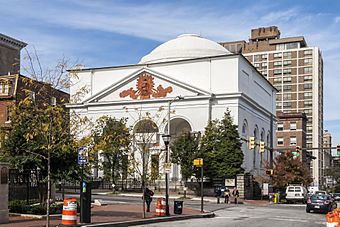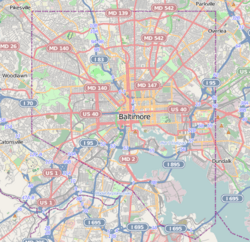First Unitarian Church (Baltimore) facts for kids
|
First Unitarian Church of Baltimore
|
|

First Unitarian Church, 2011
|
|
| Location | 10 W. Franklin St, Mount Vernon, Baltimore, Maryland |
|---|---|
| Area | 0.4 acres (0.16 ha) |
| Built | 1817 |
| Architect | J. Maximilian M. Godefroy (1765-c.1838, French émigré) |
| Architectural style | Neoclassical |
| NRHP reference No. | 72001495 |
Quick facts for kids Significant dates |
|
| Added to NRHP | February 11, 1972 |
| Designated NHL | February 20, 1972 |
The First Unitarian Church is a very old and important church building in Baltimore, Maryland. It is located at 12 West Franklin Street in the Mount Vernon area. This church was finished in 1818. It was the first building ever built specifically for Unitarians in the United States.
The church building looks like a cube with a dome on top. Its outside is covered in stucco. It was first called the "First Independent Church of Baltimore." This church is the oldest building still used by a Unitarian group. In 1935, its name changed to "The First Unitarian Church of Baltimore (Unitarian and Universalist)." This happened after it joined with another church. Later, in 1961, the two main Unitarian and Universalist groups in the U.S. joined together. They formed the Unitarian Universalist Association. The church building was named a National Historic Landmark in 1972. This means it is a very important historical place.
Contents
Building History and Design
The church building was completed in 1817. It was designed by J. Maximilian M. Godefroy. He was an architect who came from France. Godefroy also designed other famous buildings in Baltimore. These include the St. Mary's Seminary Chapel and the Battle Monument. He also helped another famous architect, Benjamin Henry Latrobe, with a large building called the Merchants' Exchange Building.
Inside the Church
At first, the sound inside the church was not very good under the big dome. So, in 1893, the inside was updated. An architect named Joseph Evans Sperry added a curved ceiling, called a barrel vault, under the dome.
The church has beautiful stained glass windows. These were made by the famous artist Louis Comfort Tiffany. The church also has a large pipe organ. This organ was given to the church by a generous person named Enoch Pratt. It is an 1893 Niemann instrument.
Enoch Pratt Parish Hall
Behind the main church building is the Enoch Pratt Parish Hall. This hall was built in 1879. It is used for church offices and other activities. It was named after Enoch Pratt in 2008. He was a member of the church and gave money to the City of Baltimore to build the Enoch Pratt Free Library.
Special Carvings
The front of the church has a special carving called a relief. It was made by Antonio Cappellano. He also made carvings for the Battle Monument. The original carving wore out over time. So, a new copy was put in its place in 1954.
Why This Church Is Important
The First Unitarian Church is very important in the history of Unitarianism. A famous speech was given here on May 5, 1819. It was called the Baltimore Sermon by William Ellery Channing. This speech helped to create the Unitarian religion as we know it today.
The church is located in the Mount Vernon neighborhood. This area is north of downtown Baltimore. It was once part of a large estate owned by Colonel John Eager Howard. He was a hero in the American Revolution. The famous Washington Monument is just two blocks north of the church.
The First Unitarian Church was added to the "National Register of Historic Places" on February 11, 1972. It was named a "National Historic Landmark" a week later, on February 20, 1972. These honors are given by the U.S. Department of the Interior and its National Park Service. The church is also part of the "Cathedral Hill Historic District" and the "Baltimore National Heritage Area."
See also




